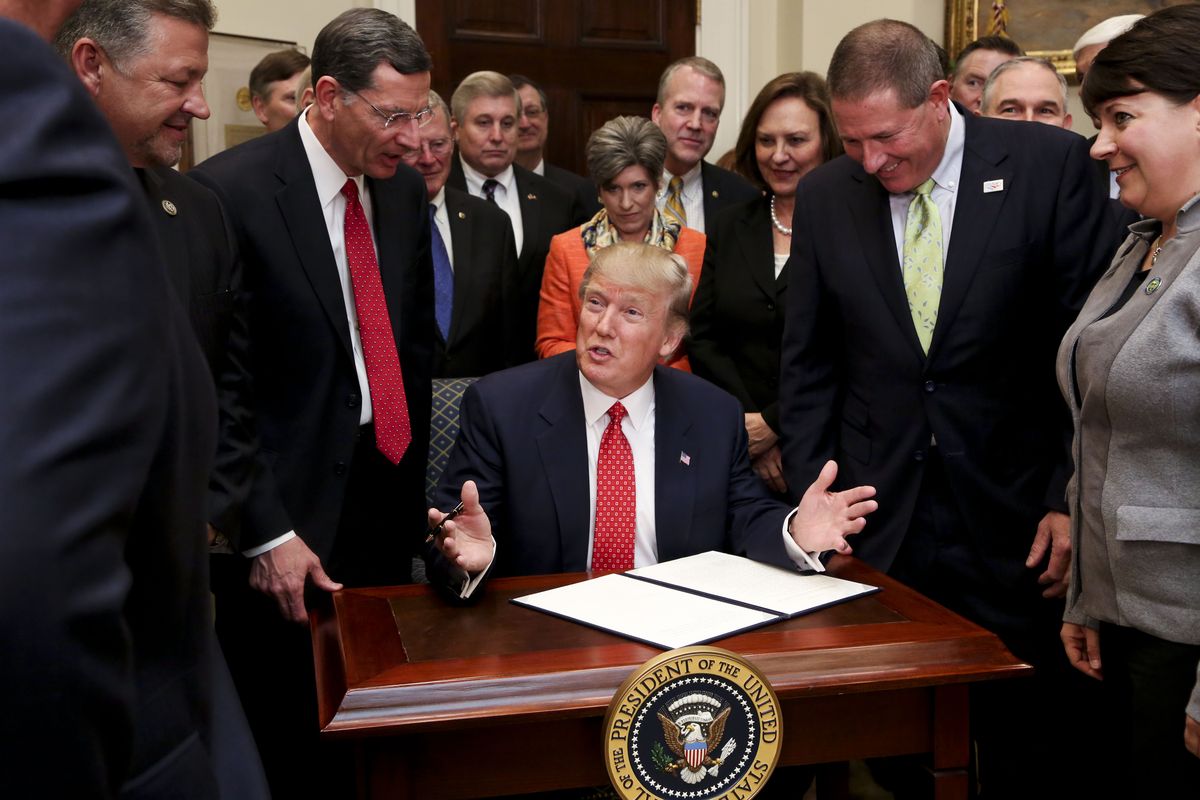Trump Signs Executive Order to Roll Back Clean Water Rule

President Trump’s newest executive orders target a water-protection rule and elevate an initiative on historically black colleges and universities into the White House.
Trump signed the executive orders in back-to-back signing ceremonies at the White House on Tuesday. The first seeks to undo the Waters of the United States Rule, an Obama administration regulation that sought to reinterpret the Clean Water Act to extend federal protections to smaller rivers and streams.
In a Roosevelt Room ceremony with farmers and lawmakers, Trump called the rule “one of the worst examples of federal regulation” and said “it has truly run amok.”
At issue: the definition of “navigable waters” under the Clean Water Act. Under the 2015 Obama rule, those waters could include, for example, anything within a 100-year floodplain or within 4,000 feet of a high-tide mark. “A few years ago, the EPA decided that ‘navigable waters’ can mean nearly every puddle or every ditch on a farmer’s land, or anyplace else that they decide — right? It was a massive power grab,” Trump said.
Trump’s plan of attack is similar to his earlier order aimed at a consumer-protection regulation called the Fiduciary Duty rule. Because the rule was finalized in 2015, the Trump administration will have to start the regulatory process from the beginning to remove it from the books. The executive order instructs the Environmental Protection Agency and the U.S. Army Corps of Engineers to do just that, asking them to reconsider whether federal jurisdiction extends to non-navigable streams.
But unlike the Fiduciary Duty Rule, which was scheduled to go into effect April 10, the Waters of the United States rule has already been blocked by a federal appeals court in Cincinnati. The executive order also asks the Justice Department to put that appeal on hold while the administration reconsiders the rule.
And it gives direct advice to agencies about how Trump would like to see the term “navigable waters” defined. In a 2005 Supreme Court decision, Justice Antonin Scalia defines them “only those relatively permanent, standing or continuously flowing bodies of water forming geographic features that are described in ordinary parlance as streams, oceans, rivers, and lakes.”
Delaware Sen. Tom Carper, the top Democrat on the Environment and Public Works Committee, did not sound optimistic that the rule would survive.
“If this were an objective review, I think that would be fine,” he said. “If this is a review that the Trump administration has already decided what the outcomes going to be, that’s not good.”
A second executive order moves the federal initiative on Historically Black Colleges and Universities, or HBCUs, into the White House from the Department of Education, where it was housed under the Obama administration.
Trump’s executive order establishes a President’s Board of Advisors on HBCUs, but still leaves much of the budgeting and administration of the initiative in the Department of Education.
“With this executive order, we will make HBCUs a priority in the White House — an absolute priority,” Trump said. “A lot of people are going to be angry that they’re not a priority, but that’s O.K.”
Grambling State University Richard Gallot, one of 80 college presidents who met with Trump Monday, welcomed moving the HBCU initiative back to the White House. “It does makes sense,” he said. “When an agency receives something from the White House suggesting action on HBCUs it has a different tone than three layers down from the Department of Education.”
Since President Jimmy Carter in 1980, every president has signed an executive order reorganizing the initiative. But Trump said moving the initiative into the White House will make it “an absolute priority.”
The HBCU order comes the day after Trump hosted the presidents of historically black colleges at the White House — cramming 64 of them into the Oval Office for a meeting. “I don’t think we’ve ever had this many people in the Oval Office,” Trump said to laughter. “This could be a new record, forever.
(h/t USA Today)
Reality
According to Vox, there is a catch: Rolling back this rule won’t be easy to do. By law, Pruitt has to go through the formal federal rulemaking process and replace Obama’s regulation with his own version — and then defend it in court as legally superior. And, as Pruitt’s about to find out, figuring out which bodies of water deserve protection is a maddeningly complex task that could take years.